Regression Machine Learning Models for the Short-Time Prediction of Genetic Algorithm Results in a Vehicle Routing Problem
Abstract
1. Introduction
2. Proposed Operations Research Problem Solving Using Machine Learning (OpReMaL) Framework
3. Case Study: Vehicle Routing Problem Resolved Using Genetic Algorithm
3.1. Vehicle Routing Problem Resolved Using Genetic Algorithm (VRP-GA)
3.2. Operations Research Problem Solving Using Machine Learning (OpReMaL) Framework Using Regression Machine Learning Models for the VRP-GA Case Study
- min_distance_depot: the minimum distance between all customer–depot pairs;
- average_distance_depot: the average distance between all customer–depot pairs;
- max_distance_depot: the maximum distance between all customer–depot pairs;
- min_distance_nondepot: the minimum distance between all customer pairs, excluding the depot;
- average_distance_nondepot: the average distance between all customer pairs, excluding the depot;
- max_distance_nondepot: the maximum distance between all customer pairs, excluding the depot;
- min_demand: the minimum demand value among all customers;
- average_demand: the average demand value of all customers;
- max_demand: the maximum demand value among all customers;
- num_customers: the number of customers considered in the instance;
- vehicle_capacity: the capacity of homogeneous trucks.
4. Numerical Experiments
5. Managerial Insights and Potential Applications
6. Conclusions
Author Contributions
Funding
Data Availability Statement
Conflicts of Interest
References
- Basso, R.; Kulcsár, B.; Sanchez-Diaz, I. Electric Vehicle Routing Problem with Machine Learning for Energy Prediction. Transp. Res. Part B Methodol. 2021, 145, 24–55. [Google Scholar] [CrossRef]
- Archetti, C.; Cordeau, J.-F.; Desaulniers, G. Introduction to the Special Issue on Combining Optimization and Machine Learning: Application in Vehicle Routing, Network Design and Crew Scheduling. EURO J. Transp. Logist. 2020, 9, 100024. [Google Scholar] [CrossRef]
- López Lázaro, J.; Barbero Jiménez, Á.; Takeda, A. Improving Cash Logistics in Bank Branches by Coupling Machine Learning and Robust Optimization. Expert Syst. Appl. 2018, 92, 236–255. [Google Scholar] [CrossRef]
- Fescioglu-Unver, N.; Yıldız Aktaş, M. Electric Vehicle Charging Service Operations: A Review of Machine Learning Applications for Infrastructure Planning, Control, Pricing and Routing. Renew. Sustain. Energy Rev. 2023, 188, 113873. [Google Scholar] [CrossRef]
- Hoang, N.-D. Image Processing Based Automatic Recognition of Asphalt Pavement Patch Using a Metaheuristic Optimized Machine Learning Approach. Adv. Eng. Inform. 2019, 40, 110–120. [Google Scholar] [CrossRef]
- Chou, J.-S.; Ngo, N.-T. Time Series Analytics Using Sliding Window Metaheuristic Optimization-Based Machine Learning System for Identifying Building Energy Consumption Patterns. Appl. Energy 2016, 177, 751–770. [Google Scholar] [CrossRef]
- Karimi-Mamaghan, M.; Mohammadi, M.; Meyer, P.; Karimi-Mamaghan, A.M.; Talbi, E.-G. Machine Learning at the Service of Meta-Heuristics for Solving Combinatorial Optimization Problems: A State-of-the-Art. Eur. J. Oper. Res. 2022, 296, 393–422. [Google Scholar] [CrossRef]
- Arnold, F.; Sörensen, K. What Makes a VRP Solution Good? The Generation of Problem-Specific Knowledge for Heuristics. Comput. Oper. Res. 2019, 106, 280–288. [Google Scholar] [CrossRef]
- Bruni, M.E.; Fadda, E.; Fedorov, S.; Perboli, G. A Machine Learning Optimization Approach for Last-Mile Delivery and Third-Party Logistics. Comput. Oper. Res. 2023, 157, 106262. [Google Scholar] [CrossRef]
- Accorsi, L.; Lodi, A.; Vigo, D. Guidelines for the Computational Testing of Machine Learning Approaches to Vehicle Routing Problems. Oper. Res. Lett. 2022, 50, 229–234. [Google Scholar] [CrossRef]
- Liebchen, C.; Schülldorf, H. A Collection of Aspects Why Optimization Projects for Railway Companies Could Risk Not to Succeed—A Multi-Perspective Approach. J. Rail Transp. Plan. Manag. 2019, 11, 100149. [Google Scholar] [CrossRef]
- De Bock, K.W.; Coussement, K.; Caigny, A.D.; Słowiński, R.; Baesens, B.; Boute, R.N.; Choi, T.-M.; Delen, D.; Kraus, M.; Lessmann, S.; et al. Explainable AI for Operational Research: A Defining Framework, Methods, Applications, and a Research Agenda. Eur. J. Oper. Res. 2023, 317, 249–272. [Google Scholar] [CrossRef]
- Singgih, I.K. Production Flow Analysis in a Semiconductor Fab Using Machine Learning Techniques. Processes 2021, 9, 407. [Google Scholar] [CrossRef]
- Singgih, I.K.; Kim, B.I. Multi-Type Electric Vehicle Relocation Problem Considering Required Battery-Charging Time. Eur. J. Ind. Eng. 2020, 14, 335. [Google Scholar] [CrossRef]
- Budiyanto, M.A.; Singgih, I.K.; Riadi, A.; Putra, G.L. Study on the LNG Distribution to Mobile Power Plants Using a Small-Scale LNG Carrier for the Case of the Sulawesi Region of Indonesia. Energy Rep. 2022, 8, 374–380. [Google Scholar] [CrossRef]
- Toth, P.; Vigo, D. Models, Relaxations and Exact Approaches for the Capacitated Vehicle Routing Problem. Discret. Appl. Math. 2002, 123, 487–512. [Google Scholar] [CrossRef]
- Scikit-Learn 1. Supervised Learning. Available online: https://scikit-learn.org/stable/supervised_learning.html (accessed on 23 January 2023).
- Kim, S.W.; Lee, Y.G.; Tama, B.A.; Lee, S. Reliability-Enhanced Camera Lens Module Classification Using Semi-Supervised Regression Method. Appl. Sci. 2020, 10, 3832. [Google Scholar] [CrossRef]
- Abid Almubaidin, M.A.; Latif, S.D.; Balan, K.; Ahmed, A.N.; El-Shafie, A. Enhancing Sediment Transport Predictions through Machine Learning-Based Multi-Scenario Regression Models. Results Eng. 2023, 20, 101585. [Google Scholar] [CrossRef]
- Wang, X.; Wang, X.; Ma, B.; Li, Q.; Wang, C.; Shi, Y. High-Performance Reversible Data Hiding Based on Ridge Regression Prediction Algorithm. Signal Process. 2023, 204, 108818. [Google Scholar] [CrossRef]
- API Reference. Available online: https://scikit-learn.org/stable/api/index.html (accessed on 2 December 2023).
- Yu, B.; Chen, C.; Wang, X.; Yu, Z.; Ma, A.; Liu, B. Prediction of Protein–Protein Interactions Based on Elastic Net and Deep Forest. Expert Syst. Appl. 2021, 176, 114876. [Google Scholar] [CrossRef]
- Lee, S.; Jun, C.-H. Fast Incremental Learning of Logistic Model Tree Using Least Angle Regression. Expert Syst. Appl. 2018, 97, 137–145. [Google Scholar] [CrossRef]
- Kramlinger, P.; Schneider, U.; Krivobokova, T. Uniformly Valid Inference Based on the Lasso in Linear Mixed Models. J. Multivar. Anal. 2023, 198, 105230. [Google Scholar] [CrossRef]
- Polat, Ö.; Kayhan, S.K. High-Speed FPGA Implementation of Orthogonal Matching Pursuit for Compressive Sensing Signal Reconstruction. Comput. Electr. Eng. 2018, 71, 173–190. [Google Scholar] [CrossRef]
- Sandhu, R.; Pettit, C.; Khalil, M.; Poirel, D.; Sarkar, A. Bayesian Model Selection Using Automatic Relevance Determination for Nonlinear Dynamical Systems. Comput. Methods Appl. Mech. Eng. 2017, 320, 237–260. [Google Scholar] [CrossRef]
- Da Silva, F.A.; Viana, A.P.; Correa, C.C.G.; Santos, E.A.; de Oliveira, J.A.V.S.; Andrade, J.D.G.; Ribeiro, R.M.; Glória, L.S. Bayesian Ridge Regression Shows the Best Fit for SSR Markers in Psidium Guajava among Bayesian Models. Sci. Rep. 2021, 11, 13639. [Google Scholar] [CrossRef] [PubMed]
- Zhu, F.; Li, H.; Li, J.; Zhu, B.; Lei, S. Unmanned Aerial Vehicle Remote Sensing Image Registration Based on an Improved Oriented FAST and Rotated BRIEF-Random Sample Consensus Algorithm. Eng. Appl. Artif. Intell. 2023, 126, 106944. [Google Scholar] [CrossRef]
- Gomes, F.J.S.; Oliveira, T.F.; Brazil, F.S.; Pamplona, A.R.; Farias, V.J.; Silveira, A.M. A Method for the Behavioral Analysis of Partial Discharges in Hydrogenerators by Generalized Linear Models. Electr. Power Syst. Res. 2016, 140, 284–287. [Google Scholar] [CrossRef]
- Jorge, J.; Paredes, R. Passive-Aggressive Online Learning with Nonlinear Embeddings. Pattern Recognit. 2018, 79, 162–171. [Google Scholar] [CrossRef]
- Singgih, I.K.; Ferdinand, F.N. Mathematical Modeling Education Using an Online Serious Game. In Proceedings of the 2019 5th International Conference on New Media Studies (CONMEDIA), Bali, Indonesia, 9–11 October 2019; pp. 184–188. [Google Scholar]
- Singgih, I.K.; Lee, J.; Kim, B.-I. Node and Edge Drone Surveillance Problem with Consideration of Required Observation Quality and Battery Replacement. IEEE Access 2020, 8, 44125–44139. [Google Scholar] [CrossRef]
- Yan, T.; Lu, F.; Wang, S.; Wang, L.; Bi, H. A Hybrid Metaheuristic Algorithm for the Multi-Objective Location-Routing Problem in the Early Post-Disaster Stage. J. Ind. Manag. Optim. 2023, 19, 4663–4691. [Google Scholar] [CrossRef]
- Bi, H.; Zhu, X.; Lu, F.; Huang, M. The Meal Delivery Routing Problem in E-Commerce Platforms under the Shared Logistics Mode. J. Theor. Appl. Electron. Commer. Res. 2023, 18, 1799–1819. [Google Scholar] [CrossRef]
- Lu, F.; Chen, W.; Feng, W.; Bi, H. 4PL Routing Problem Using Hybrid Beetle Swarm Optimization. Soft Comput. 2023, 27, 17011–17024. [Google Scholar] [CrossRef]
- Lu, F.; Bi, H.; Huang, M.; Duan, S. Simulated Annealing Genetic Algorithm Based Schedule Risk Management of IT Outsourcing Project. Math. Probl. Eng. 2017, 2017, e6916575. [Google Scholar] [CrossRef]
- Lu, F.; Feng, W.; Gao, M.; Bi, H.; Wang, S. The Fourth-Party Logistics Routing Problem Using Ant Colony System-Improved Grey Wolf Optimization. J. Adv. Transp. 2020, 2020, e8831746. [Google Scholar] [CrossRef]
- Tama, B.A.; Lim, S. Ensemble Learning for Intrusion Detection Systems: A Systematic Mapping Study and Cross-Benchmark Evaluation. Comput. Sci. Rev. 2021, 39, 100357. [Google Scholar] [CrossRef]

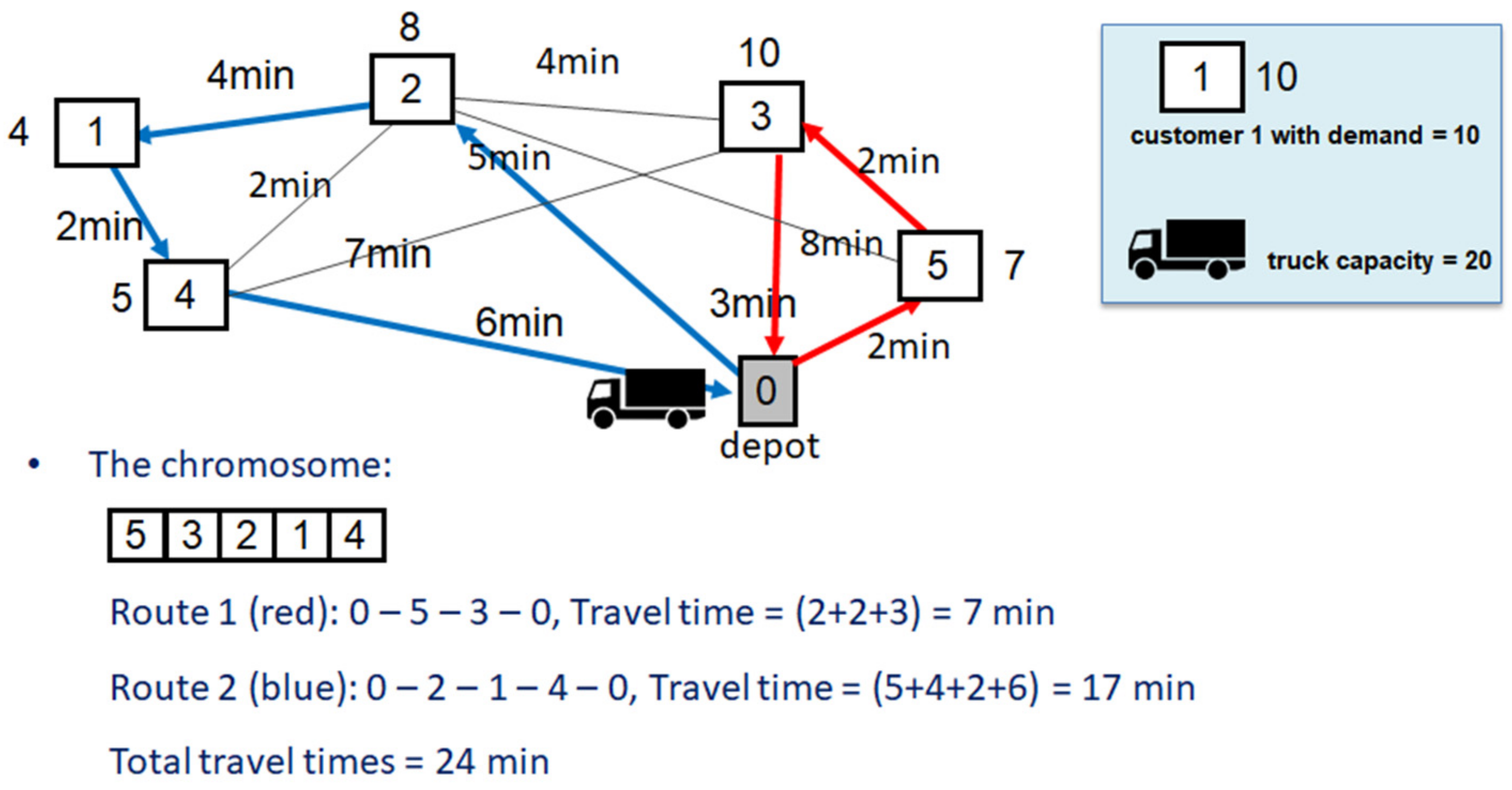
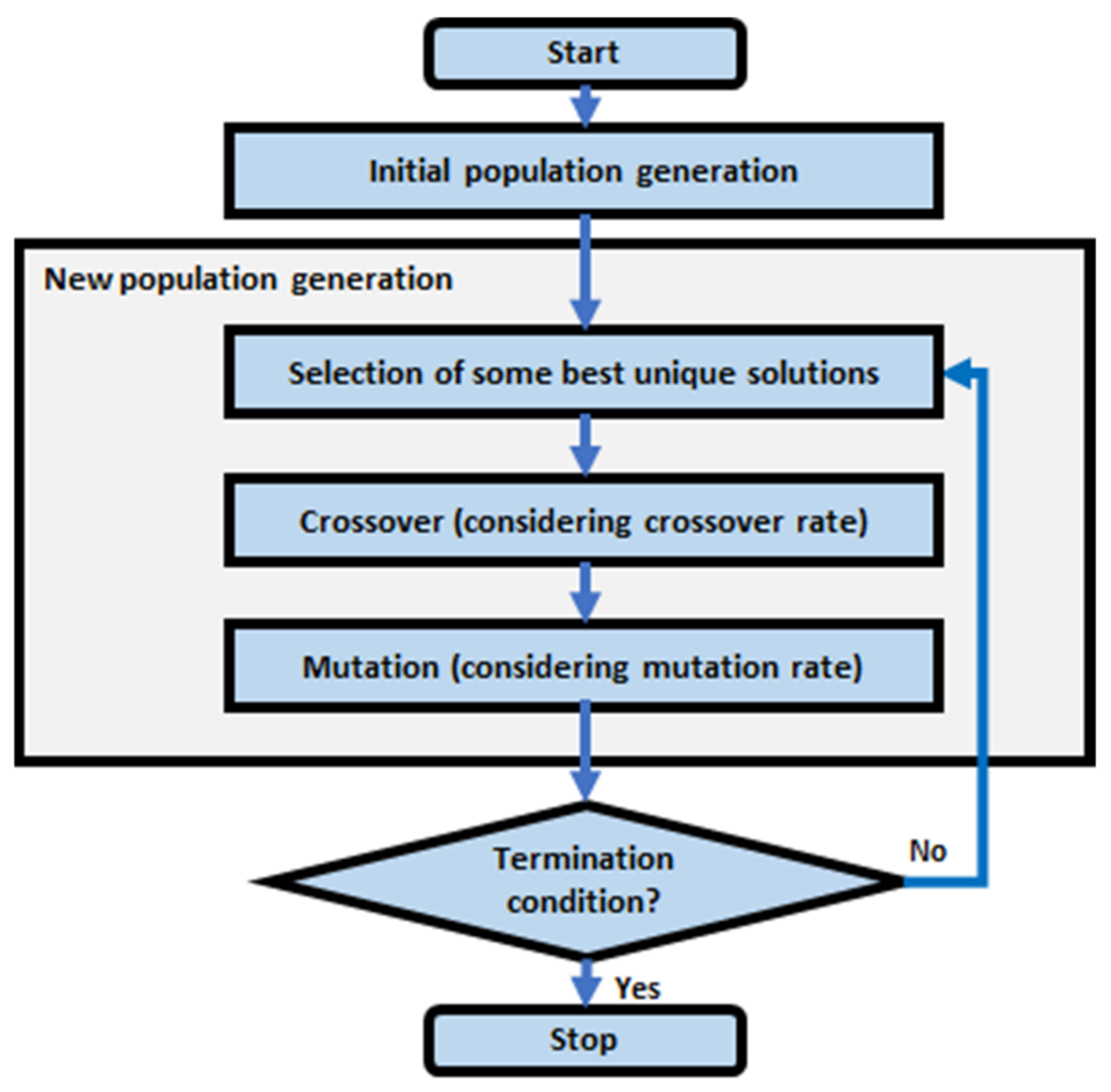
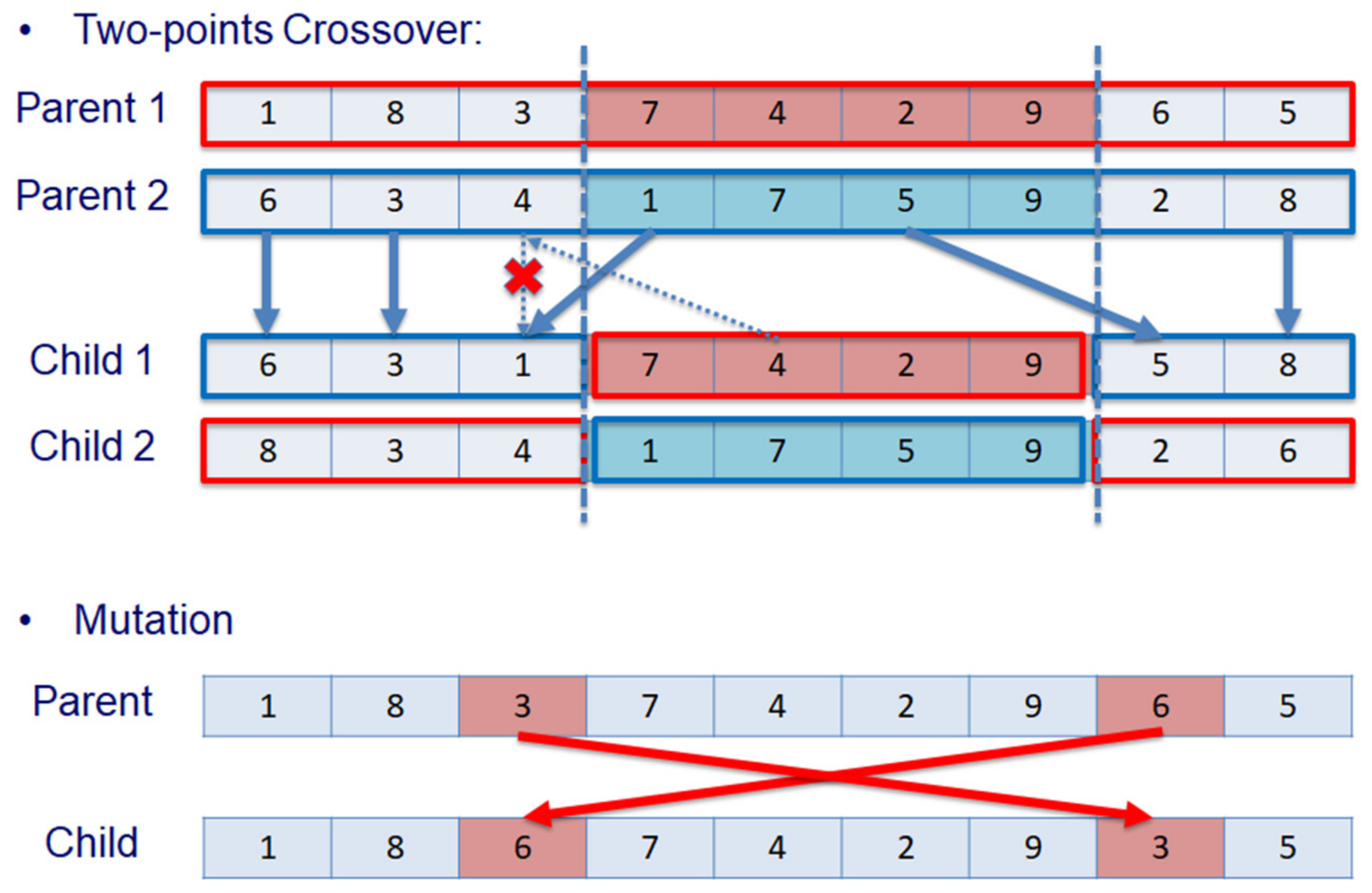
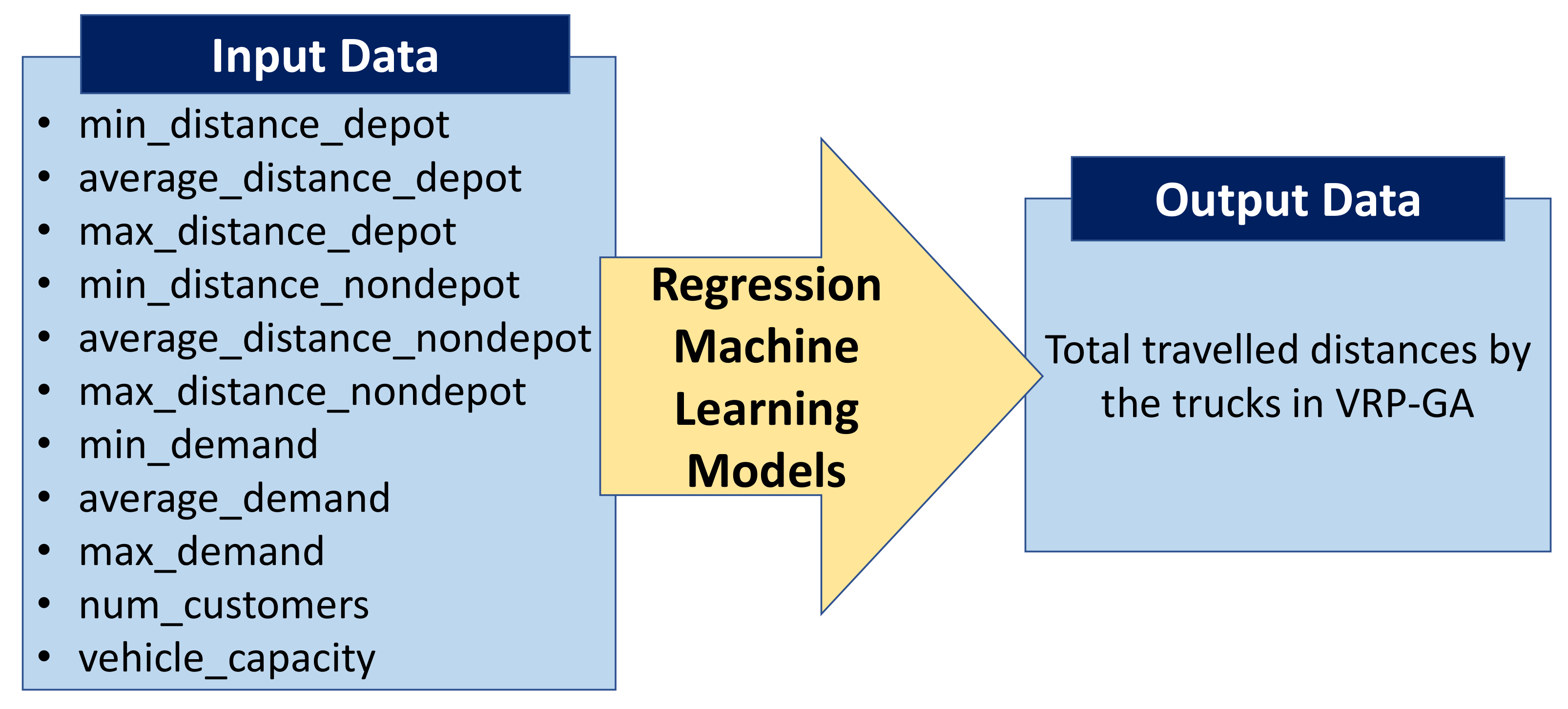
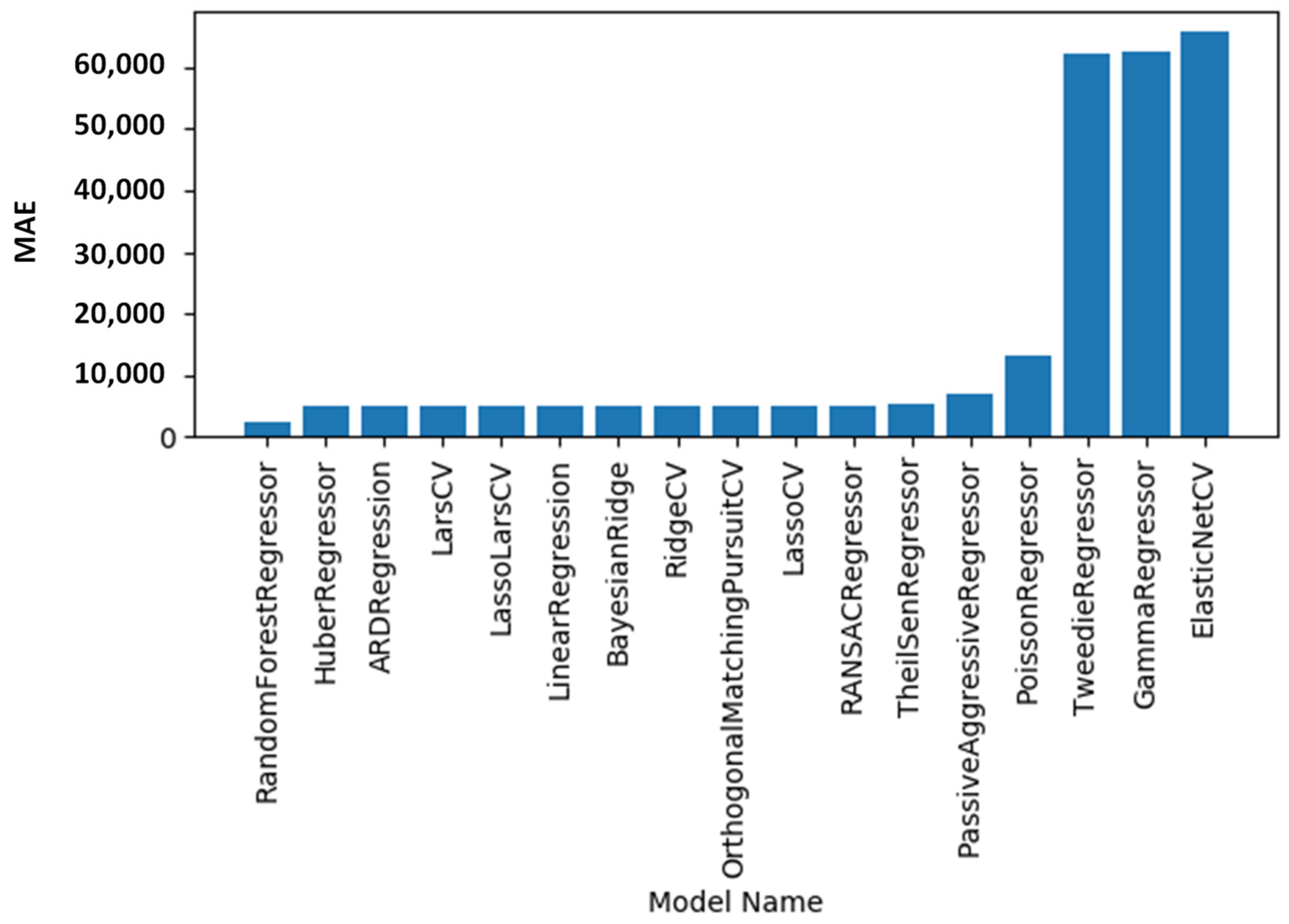
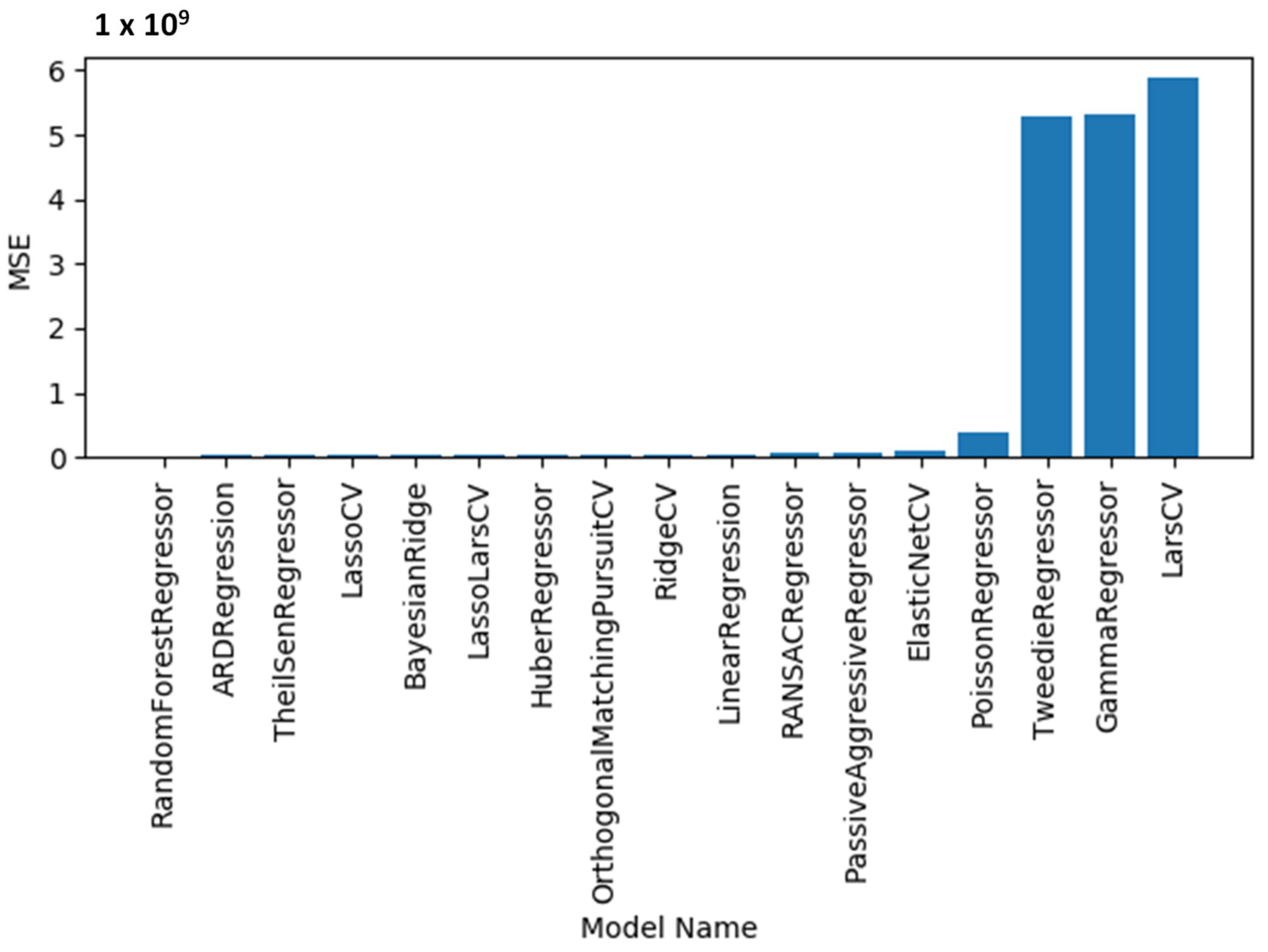
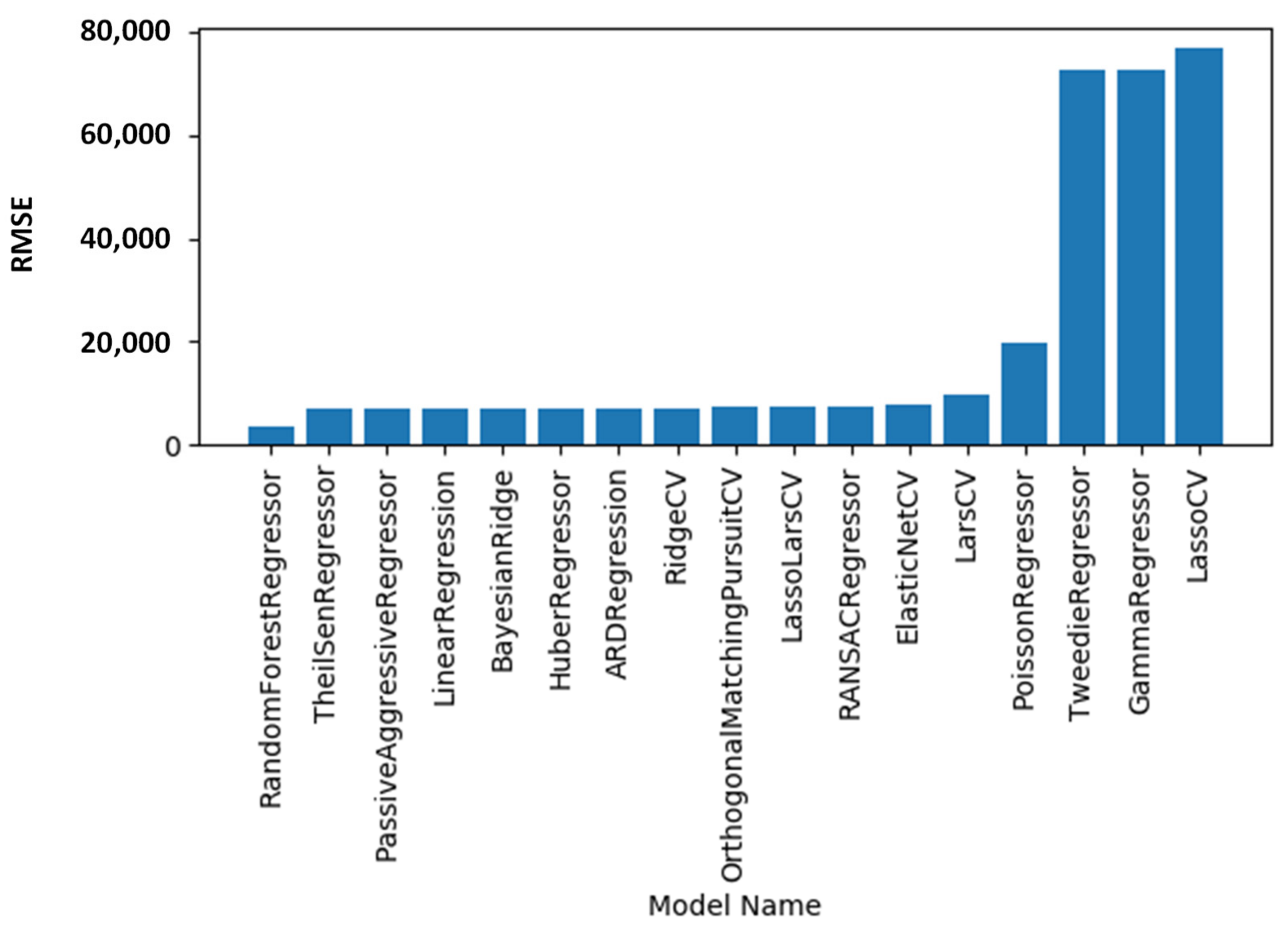
| Set of Instances | Number of Instances | Number of Customers 1 | population_size | num_of_selected_ initial_chromosomes | num_of_ populations | Average Computational Time Using the GA (s) |
|---|---|---|---|---|---|---|
| Set 1 | 2000 | [10, 100] | 50 | 30 | 50 | 4 |
| Set 2 | 2000 | [201, 300] | 50 | 30 | 50 | 16 |
| Set 3 | 500 | [401, 500] | 100 | 50 | 100 | 181 |
| Set 4 | 50 | [601, 700] | 200 | 80 | 200 | 1811 |
| Characteristic or Parameter | Value |
|---|---|
| Map width (square area) | 1000 |
| Customer demand | [30, 100] |
| Homogeneous truck capacity | 300, 400, or 500 |
| crossover_rate | 0.8 |
| mutation_rate | 0.2 |
| Regression Machine Learning Model | Explanation |
|---|---|
| (1) Random Forest Regression | An ensemble method consisting of some decision trees. It considers the decision trees’ diversity when making decisions [18]. |
| (2) Linear Regression | A linear equation used to represent relationships between variables, generated based on the observed data [19]. |
| (3) RidgeCV | A multiple linear regression with a reduction in the weights of unimportant coefficients (ridge regression) and cross-validation. It allows the greater generalization of the prediction model [20,21]. |
| (4) ElasticNetCV | A regularization method that eliminates the redundancy of variables. It has some penalty terms that are used as a compromise strategy between the LASSO and ridge regression techniques [22]. ElasticNetCV is an ElasticNet with cross-validation [21]. |
| (5) LarsCV | A linear regression machine learning model that starts with all coefficients equal to 0 and then gradually updates the coefficients after identifying the most correlated input with the output data. It is very efficient because of its piecewise linear solution paths [23]. LarsCV applies cross-validation [21]. |
| (6) LassoCV | A linear regression machine learning model with the least absolute shrinkage and selection operator (LASSO) that selects variables and determines regression coefficients simultaneously in one step [24]. LassoCV applies cross-validation [21]. |
| (7) LassoLarsCV | A cross-validated LASSO, applied in the LARS algorithm [21]. |
| (8) OrthogonalMatchingPursuitCV | A method that iteratively selects the feature that has the largest correlation with the current residual. Each selected feature will then be projected to the span of selected features. The iteration continues until K columns are selected [25]. It applies cross-validation [21]. |
| (9) ARDRegression | A Bayesian model with automatic relevance determination that prunes redundant features by estimating the parameters of the data distribution based on a maximum likelihood consideration [26]. |
| (10) BayesianRidge | A Bayesian method that considers a common variance for all regression coefficients [27]. |
| (11) HuberRegressor | A regression machine learning model that is robust to outlier data due to considering a linear loss for such outlier data [21]. |
| (12) RANSACRegressor | An iterative algorithm that conducts the robust estimation of parameters based on inliers from the data after randomly extracting matching points. The inliers are determined based on a threshold [21,28]. |
| (13) TheilSenRegressor | A median-based estimator that uses generalization in multiple dimensions, allowing it to be robust to multivariate outliers [21]. |
| (14) PoissonRegressor | A generalized linear model that considers the dependent variables to be independent and random variables that follow a Poisson distribution [29]. |
| (15) TweedieRegressor | A generalized linear model that considers the dependent variables to be independent and random variables that follow a Tweedie distribution [21]. |
| (16) GammaRegressor | A generalized linear model that considers the dependent variables to be independent and random variables that follow a Gamma distribution [21]. |
| (17) PassiveAggressiveRegressor | An online learning regression machine learning model that learns data that are added continuously [30]. It is suitable for large-scale learning [21]. |
| Regression Machine Learning Model | MAE | MSE | RMSE |
|---|---|---|---|
| (1) Random Forest Regression | * 2216 | * 12,204,263 | * 3493 |
| (2) Linear Regression | 5013 | 51,871,442 | 7202 |
| (3) RidgeCV | 5015 | 51,800,637 | 7197 |
| (4) ElasticNetCV | 65,859 | 5,903,239,905 | 76,832 |
| (5) LarsCV | 5013 | 51,871,442 | 7202 |
| (6) LassoCV | 5038 | 52,427,706 | 7240 |
| (7) LassoLarsCV | 5013 | 51,871,442 | 7202 |
| (8) OrthogonalMatchingPursuitCV | 5037 | 52,412,692 | 7239 |
| (9) ARDRegression | 5013 | 51,956,577 | 7208 |
| (10) BayesianRidge | 5013 | 51,868,066 | 7201 |
| (11) HuberRegressor | 4940 | 56,948,824 | 7546 |
| (12) RANSACRegressor | 5043 | 51,806,962 | 7197 |
| (13) TheilSenRegressor | 5369 | 58,285,906 | 7634 |
| (14) PoissonRegressor | 13,100 | 397,203,436 | 19,929 |
| (15) TweedieRegressor | 62,313 | 5,299,130,027 | 72,795 |
| (16) GammaRegressor | 62,694 | 5,312,249,478 | 72,885 |
| (17) PassiveAggressiveRegressor | 6847 | 92,361,365 | 9610 |
| Set of Instances | Best MAE | Average Objective Value | Best Model | Computational Time (s) |
| Set 1 | 932.58 (3.8%) | 24,863 | Random Forest Regression | 2 |
| Set 2 | 2142.51 (1.6%) | 132,821 | PoissonRegressor | <1 |
| Set 3 | 3839.04 (1.6%) | 234,490 | PoissonRegressor | <1 |
| Set 4 | 3452.44 (1.1%) | 318,115 | RidgeCV | <1 |
| Set of Instances | Best MSE | Best Model | Computational Time (s) |
|---|---|---|---|
| Set 1 | 1,456,221.20 | Random Forest Regression | 2 |
| Set 2 | 7,513,768.98 | PoissonRegressor | <1 |
| Set 3 | 23,010,249.50 | PoissonRegressor | <1 |
| Set 4 | 18,644,231.03 | RidgeCV | <1 |
| Set of Instances | Best RMSE | Best Model | Computational Time (s) |
|---|---|---|---|
| Set 1 | 1206.74 | Random Forest Regression | 2 |
| Set 2 | 2741.13 | PoissonRegressor | <1 |
| Set 3 | 4796.90 | PoissonRegressor | <1 |
| Set 4 | 4317.90 | RidgeCV | <1 |
Disclaimer/Publisher’s Note: The statements, opinions and data contained in all publications are solely those of the individual author(s) and contributor(s) and not of MDPI and/or the editor(s). MDPI and/or the editor(s) disclaim responsibility for any injury to people or property resulting from any ideas, methods, instructions or products referred to in the content. |
© 2024 by the authors. Licensee MDPI, Basel, Switzerland. This article is an open access article distributed under the terms and conditions of the Creative Commons Attribution (CC BY) license (https://creativecommons.org/licenses/by/4.0/).
Share and Cite
Singgih, I.K.; Singgih, M.L. Regression Machine Learning Models for the Short-Time Prediction of Genetic Algorithm Results in a Vehicle Routing Problem. World Electr. Veh. J. 2024, 15, 308. https://doi.org/10.3390/wevj15070308
Singgih IK, Singgih ML. Regression Machine Learning Models for the Short-Time Prediction of Genetic Algorithm Results in a Vehicle Routing Problem. World Electric Vehicle Journal. 2024; 15(7):308. https://doi.org/10.3390/wevj15070308
Chicago/Turabian StyleSinggih, Ivan Kristianto, and Moses Laksono Singgih. 2024. "Regression Machine Learning Models for the Short-Time Prediction of Genetic Algorithm Results in a Vehicle Routing Problem" World Electric Vehicle Journal 15, no. 7: 308. https://doi.org/10.3390/wevj15070308
APA StyleSinggih, I. K., & Singgih, M. L. (2024). Regression Machine Learning Models for the Short-Time Prediction of Genetic Algorithm Results in a Vehicle Routing Problem. World Electric Vehicle Journal, 15(7), 308. https://doi.org/10.3390/wevj15070308






